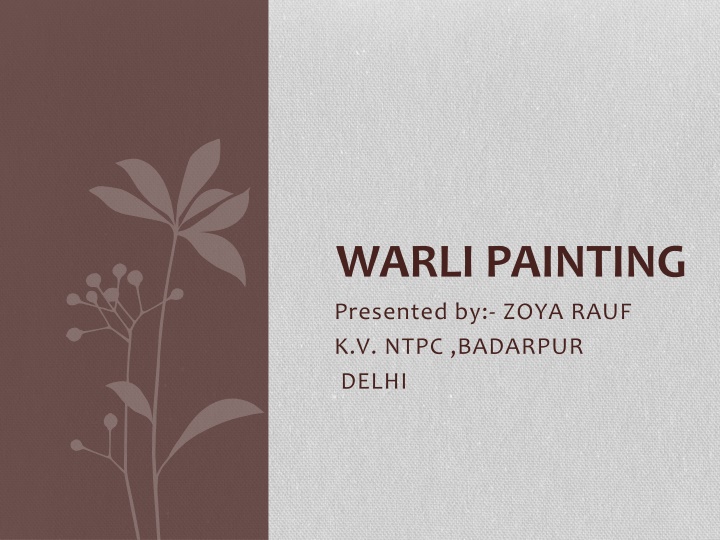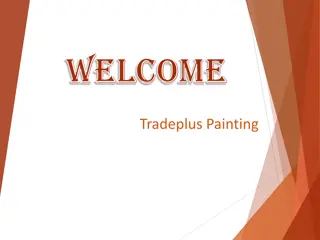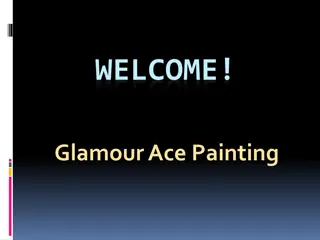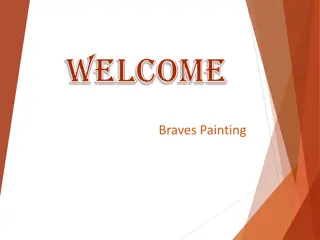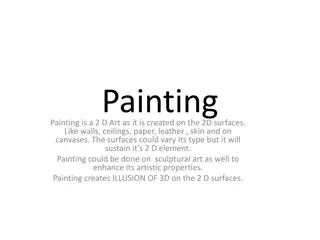The Fascinating World of Warli Painting
Warli painting is a traditional art form practiced by the Warli tribe of Maharashtra and Gujarat. Known for its unique graphic vocabulary and depiction of daily life and nature, these paintings capture the essence of tribal culture. Learn about the origin, themes, and materials required for creating Warli art, along with step-by-step instructions. Dive into the rich heritage and symbolic significance of Warli paintings in this vivid artistic expression.
Download Presentation

Please find below an Image/Link to download the presentation.
The content on the website is provided AS IS for your information and personal use only. It may not be sold, licensed, or shared on other websites without obtaining consent from the author.If you encounter any issues during the download, it is possible that the publisher has removed the file from their server.
You are allowed to download the files provided on this website for personal or commercial use, subject to the condition that they are used lawfully. All files are the property of their respective owners.
The content on the website is provided AS IS for your information and personal use only. It may not be sold, licensed, or shared on other websites without obtaining consent from the author.
E N D
Presentation Transcript
WARLI PAINTING Presented by:- ZOYA RAUF K.V. NTPC ,BADARPUR DELHI
BEGINNING OF WARLI PAINTING The warlis or an indigenous tribe living in mountain as well as coastal areas of Maharashtra and Gujarat. Warli Art is the vivid expression of daily and social events and is embellished on the walls of village houses. The paintings depict the daily routine of the Warlis, with some of the fertility gods. The characters in the Warli painting are usually dancing, with hands in hands in a circular manner. The central motif in these ritual paintings is surrounded by scenes portraying hunting, fishing and farming, festivals and dances, trees and animals. The themes are highly repetitive and symbolic.
Warli Paintings employ a very basic graphic vocabulary: a circle, a triangle and a square. The circle represents the sun and the moon, the triangle is derived from mountains and pointed trees and the square determines the sacred enclosure or a piece of land. Human and animal bodies are represented by two triangles joined at the tip; the upper triangle depicts the trunk and the lower triangle the pelvis. Their precarious equilibrium symbolizes the balance of the universe, and of the couple, and has the practical and amusing advantage of animating the bodies. The Warli art is an ingenious example of man-environment interaction. Of course, the painting has now moved on to paper and is put up on T Shirts, Dupattas, Saris, etc .
MATERIALS REQUIRED SHEET (pastel or cartraidge) COROGATE SHEET Clay Brushes Pencil Colour (white)
STEPS TO BE FOLLOWED Take cartridge sheet or corogate sheet. Prepare a surface with the help of diluted clay and brush. Leave it for some time to get dry. Prepare a layout of warli painting on sheet. Draw warli art form on carogate sheet with white poster colour through the brush. Ensure the board should be completely dry before the drawing. Draw composition with the use of circle, square and triangle.
LEARNING OUTCOME Children will get knowledge about folk art of India. Children will paint without using pencil. We can encourage to student to paint the school wall. It can be done in canvases, wall and paper etc. Students will create a warli painting with the help of clay and carogated sheet. Students will learn warli painting in simplest way.
THANK YOU ALL OF YOU FOR BEING A PART OF MY PRESENTATION.
